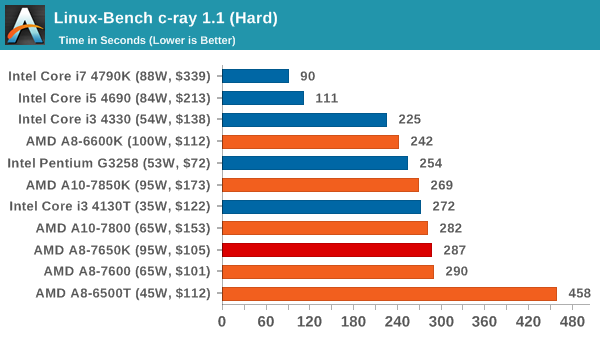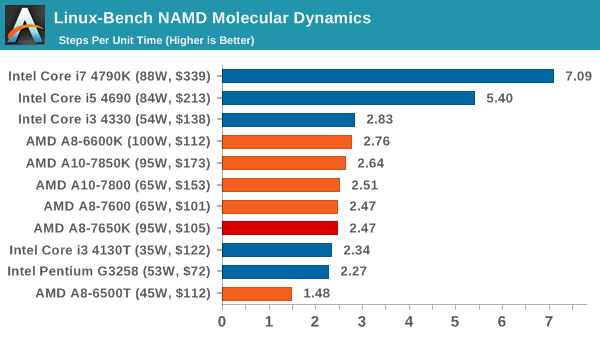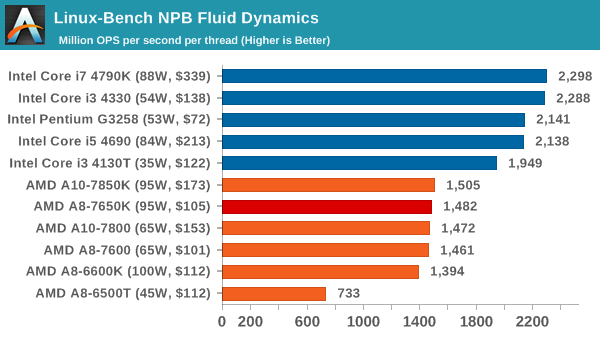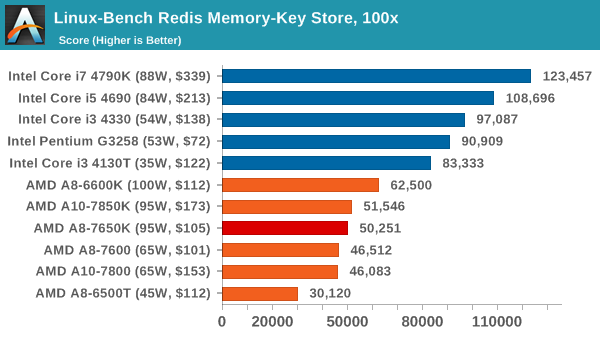The AMD A8-7650K APU Review, Also New Testing Methodology
by Ian Cutress on May 12, 2015 10:00 AM ESTProfessional Performance: Linux
Built around several freely available benchmarks for Linux, Linux-Bench is a project spearheaded by Patrick at ServeTheHome to streamline about a dozen of these tests in a single neat package run via a set of three commands using an Ubuntu 11.04 LiveCD. These tests include fluid dynamics used by NASA, ray-tracing, OpenSSL, molecular modeling, and a scalable data structure server for web deployments. We run Linux-Bench and have chosen to report a select few of the tests that rely on CPU and DRAM speed.
C-Ray: link
C-Ray is a simple ray-tracing program that focuses almost exclusively on processor performance rather than DRAM access. The test in Linux-Bench renders a heavy complex scene offering a large scalable scenario.

Being a scaling benchmark, C-Ray prefers threads and seems more designed for Intel.
NAMD, Scalable Molecular Dynamics: link
Developed by the Theoretical and Computational Biophysics Group at the University of Illinois at Urbana-Champaign, NAMD is a set of parallel molecular dynamics codes for extreme parallelization up to and beyond 200,000 cores. The reference paper detailing NAMD has over 4000 citations, and our testing runs a small simulation where the calculation steps per unit time is the output vector.

NAMD is similar to our office benchmarks, puttin the bulk of the APUs between the i3-4130T and the i3-4330.
NPB, Fluid Dynamics: link
Aside from LINPACK, there are many other ways to benchmark supercomputers in terms of how effective they are for various types of mathematical processes. The NAS Parallel Benchmarks (NPB) are a set of small programs originally designed for NASA to test their supercomputers in terms of fluid dynamics simulations, useful for airflow reactions and design.

Despite the rated memory on the APUs being faster, NPB seems to require more IPC than DRAM speed.
Redis: link
Many of the online applications rely on key-value caches and data structure servers to operate. Redis is an open-source, scalable web technology with a b developer base, but also relies heavily on memory bandwidth as well as CPU performance.











177 Comments
View All Comments
Michael Bay - Wednesday, May 13, 2015 - link
If this abomination is all about mobile applications, no wonder one has to search with a flashlight for an hour to find a notebook on AMD, and then it`s some 15 inch tn+ crap.And in daily use it`s extremely easy to spot a difference, since systems on AMD will always have wailing CO.
jabber - Wednesday, May 13, 2015 - link
Yep the OEMs just don't want or need AMD anymore.Pissedoffyouth - Tuesday, May 12, 2015 - link
Works great for extremely micro buildsharrkev - Tuesday, May 12, 2015 - link
Ummm. Not quite. For desktop, the APU concept might be mostly irrelevant unless on a tight budget. For laptop people (like me), the APU is everything. To get a discrete graphics chip, you are generally looking at north of $1000. If your laptop budget is around $500 or so and you want to play the occasional game, the APU matters. An AMD processor will game circles around and Intel chip if using built-in graphics.My dream machine right now is a laptop with a high-end Carrizo and a displayPort to drive big monitors.
jabber - Tuesday, May 12, 2015 - link
Just a shame you'll never see one in the stores!LogOver - Tuesday, May 12, 2015 - link
AMD integrated graphics is better than Intel's... but only if we're talking about desktop offerings with 95W TDP. AMD mobile offering (low power apus with "good enough" graphics) is pretty much non existent.TheinsanegamerN - Wednesday, May 13, 2015 - link
coming from someone who had an AMD APU notebook, no. AMD's graphics are nowhere near as nice in mobile, where the low TDP hammers them. When it comes to games, intel's hd 4600 ran circles around the a10-4600m and the a10-5750m. framerates were not only higher, but much more consistent. AMD's kaveri chips were 15 watt, and still couldnt match 15 watt intel chips.geekfool - Tuesday, May 12, 2015 - link
Did you look into why i3-4130T ended up faster in x265 than i3-4330? The latter is strictly faster and there is no turbo that could difference things due to individual chip quality. I suspect some of those results must be wrong, which sorta casts shadow onto all of them.(I hope you didn't mix different x265 versions, because the encoder is continually being optimised and thus newer versions do more work per MHz than older ones? You don't ever say what parameters/data the the tests use, so it is hard to guess what went wrong).
rp1367 - Tuesday, May 12, 2015 - link
It seems you have a better idea in designing silicon than AMD. Why not make your own silicon so that you will be impressed by your pwn expectation? The APU is a revolutionary design and no silicon maker can match this on general purpose use from office to gaming.jeffry - Tuesday, May 12, 2015 - link
I think this PC setup is a good option. we all shop on budgets, i dont know anyone who does not. if more money comes in, say, 6-12 month later, i would just buy a dedicated GPU (~150 bucks) and thats it...